Low-Water-Use Groundcovers
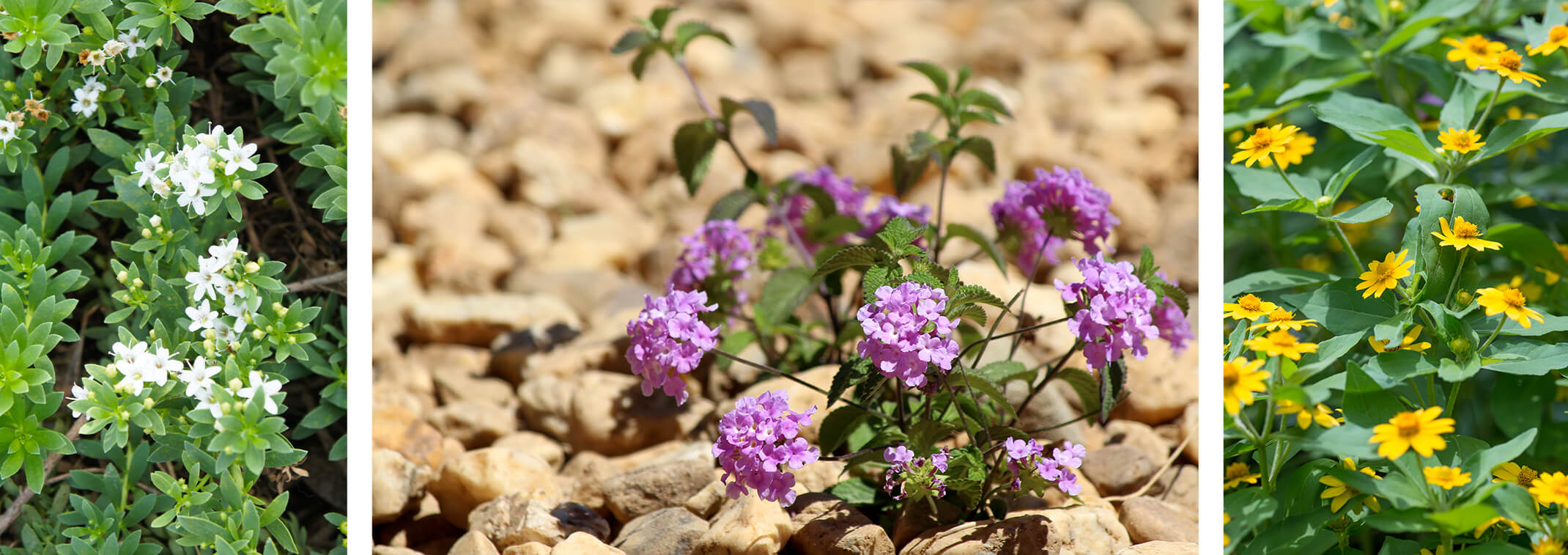
11 Groundcovers for Desert Gardens
If you’re looking for some Earth-friendly groundcovers to add color and texture to your garden landscape, or for some alternatives to growing a traditional lawn, following we’ve got some great low-water-use options to choose from, and they grow well in the Valley!
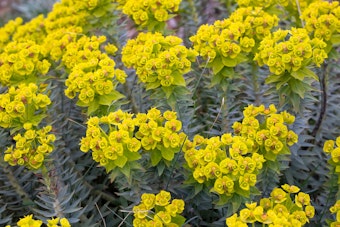
1. Blue Euphorbia
- Uses: Commonly known as Silver Spurge, Upright Myrtle Spurge and Gopher Plant (Euphorbia rigida - formerly known as Euphorbia biglandulosa) is a great choice for a groundcover. Grows well in rock gardens, xeriscapes, and desert garden landscapes, as well as in containers.
- Growth Habit: This spreading and stiffly upright subshrub grows 2 ft. tall and 3-5 ft. wide.
- Color: Yellow flowers (that age to orange) bloom in spring atop succulent gray-green foliage.
- Fruit: Produces green, multi-carpulate fruits
- Soil: Prefers well-drained soil
- Light: For elongated stems, grow in partial shade; for a tight, rounded canopy grow in full sun.
- Water: Once established, requires infrequent regular watering in summer; does not require supplemental water in winter
- Pruning: Growth is best rejuvenated when cut back severly in early fall.
- Hardiness: 10 to 20oF
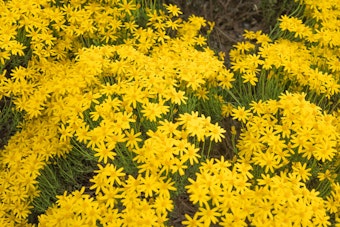
2. Damianita
- Uses: Damianita (Chrysactinia mexicana) can be massed together to create a beautiful, large-scale, flowering groundcover. Excellent for use in xeriscapes or in oasis landscape designs; can also be used as an edging/border
- Growth Habit: This short-lived perennial subshrub is evergreen, woody and will slowly grow to 18 inches tall and 3 feet wide
- Color: 1-inch in diameter, small yellow flowers grow in masses primarily during spring atop small, strongly aromatic medium to dark green leaves
- Fruit: Produces small hairy fruits that disperse with wind
- Soil: Needs well-drained soil
- Light: Grow in full sun
- Water: Once established, will require supplemental watering in summer — especially during extreme heat
- Pruning: To promote vigor, prefers a very light shearing in fall
- Hardiness: Has difficulty tolerating temperatures above 110°F; cold hardy to 0°F
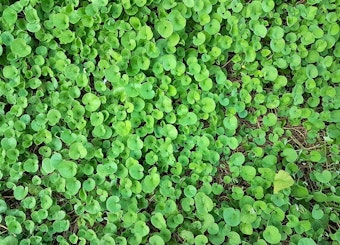
3. Dichondra
- Uses: Dichondra repens, commonly available as seed and also known as Kidney Weed or Lawn Leaf, is an excellent ground cover choice for gardeners seeking a low-maintenance lawn alternative. It's particularly suited for rock gardens, xeriscapes, and green roofs due to its ability to form a dense mat of foliage. It also performs well in container gardens and hanging baskets, adding a lush, cascading element.
- Growth Habit: This perennial ground cover forms a thick carpet of small, kidney-shaped leaves, typically staying very low to the ground, about 2 inches in height, but can spread up to several feet wide.
- Color: The leaves of Dichondra repens are a deep green with a soft, velvety texture, providing a vibrant ground cover throughout the year. It rarely flowers in dense growth, but when it does, the flowers are small, inconspicuous, and white.
- Fruit: It seldom produces noticeable fruits, as its primary aesthetic appeal lies in its lush foliage.
- Soil: Prefers well-drained, fertile soil, but can tolerate a range of soil types, provided they are not waterlogged.
- Light: Thrives best in partial shade but can tolerate full sun in cooler regions. In very hot climates like Phoenix, AZ, some shade during the hottest part of the day helps maintain its lush appearance. Great for planting near a tree or in a shaded area where it is difficult to grow a traditional lawn.
- Water: Once established, it needs minimal watering but should be kept consistently moist, especially in hot, dry weather. It's more drought-tolerant than traditional lawns but will require regular watering to remain lush and green.
- Pruning: Minimal pruning is required. It can be mowed or clipped occasionally to keep a tidy appearance if being used as a lawn substitute.
- Hardiness: Generally hardy to approx. 25°F to 30°F. In Phoenix, which is typically USDA zone 9b, it will tolerate the heat well with adequate water and some shade protection during peak summer months. This makes Dichondra repens a robust option for sustainable, low-water landscaping in warm climates.
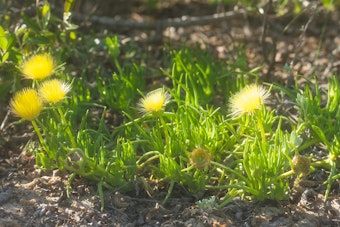 4. Rocky Point Ice Plant
4. Rocky Point Ice Plant
- Uses: Rocky Point Ice Plant is ideal for use as a ground cover, in rock gardens, borders, and for erosion control on slopes.
- Growth Habit: Low-growing, spreading succulent, about 6 inches high and 2-3 feet wide.
- Color: Vibrant orange flowers in spring and sporadically through fall; green fleshy leaves.
- Soil: Prefers well-drained sandy or gravelly soils; avoid waterlogged conditions.
- Light: Prefers full sun — at least 6 hours of direct sunlight daily
- Water: Drought-tolerant once established; water infrequently but deeply
- Hardiness: Typically hardy to about 20°F to 25°F. It can handle occasional light frosts and short cold snaps.
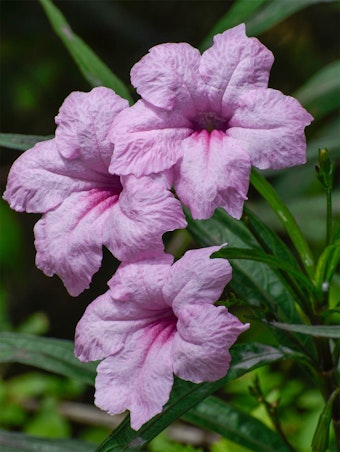
5. Katie Ruellia
- Uses: Katie Ruellia (Ruellia brittoniana 'Katie') makes an excellent pollinator-attracting colorful groundcover that can even be enjoyed poolside! Great for xeriscapes, and can also be grown in containers.
- Growth Habit: This refined, herbaceous perennial has a moderate growth rate to 1 ft. tall and 2 ft. wide with a mound form once mature
- Color: Purple flowers bloom in spring and fall atop evergreen dark green foliage
- Soil: Tolerant of a wide variety of soils
- Light: Prefers full sun or partial sun
- Water: Drought-tolerant, once established.
- Hardiness: 28°F
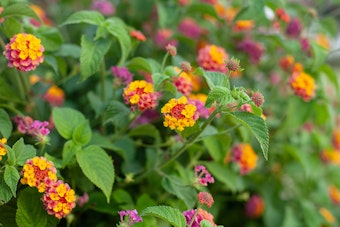
6. Lantana & Trailing Lantana
- Uses: Common Lantana (Lantana camara) - shown above, and Trailing Lantana (Lantana montevidensis) - shown top of page, center, can offer a wide variety of uses in your desert landscape and garden. Lantana can be used as a summer annual or as a perennial, large-scale groundcovere, accent shrub, informal hedge, or grown in containers and hanging baskets. Excellent for use in oasis landscape design.
- Growth Habit: Mostly an evergreen perennial subshrub that is herbaceous and tender. Depending on the type of cultivar, its growth habit can range from an upright shrub that grows 6 ft. tall to a prostrate, spreading groundcover shrub less than 18 inches tall.
- Color: Lantana is available in a wide variety of colors including, white, orange, pink, red, purple and multi-colored and produces flowers throughout most of the year!
- Fruit: Flowers are followed by black berries
- Soil: Tolerant of a wide variety of soils
- Light: Prefers full sun to partial shade; will not tolerate full shade
- Water: Requires regular waterings — especially during summer months
- Pruning: Lightly prune as needed. Can be headed back hard to almost ground level in early spring once there is no danger of frost. If it suffers frost damage, wait until early spring to remove unsightly or dead shoots, in order to protect living shoots underneath from further injury from the cold.
- Hardiness: Genearally speaking, lantana is heat-loving but cold sensitive. Most varieties will suffer frost and freeze injuries in exposed locations. Lantana montevidensis is the most cold tolerant but will suffer freeze damage below 27° F.

7. Bush Morning Glory
- Uses: Bush Morning Glory (Convolvulus cneorum) makes an excellent large-scale groundcover in mass plantings in xeriscapes, rock gardens and oasis landscape designs. Also makes an excellent accent plant.
- Growth Habit: Symmetrically mounds and spreads to 2 ft. tall and 4 ft. wide
- Color: Initially pink flowers turn brilliant white, with yellow throats, in spring (followed by pink sepals) and grow atop silver-gray foliage
- Fruit: Inconsipcuous fruits
- Soil: Requires fast-draining soil. Bush morning glory prefers sandy or gravelly, slightly alkaline soils.
- Light: Grow in full sun
- Water: Does not tolerate wet, over-watered soil conditions. Once established requires supplemental water at least every other week in the summer. Does not need supplemental water in winter.
- Pruning: This vigorous plant requires little to no pruning, and can be lightly sheared in late April (after flowering) if desired.
- Hardiness: 10 to 15°F
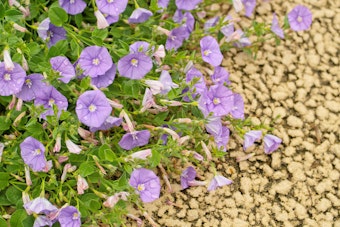
8. Ground Morning Glory
- Uses: Ground Morning Glory (Convolvulus sababius or mauritanicus) makes an excellent small-scale groundcover for use in rock gardens and oasis landscape designs
- Growth Habit: This woody perennial has a compact evergreen cover that is prostrate, soft and delicate. Slightly spreads and mounds with age to 1.5 ft. tall and 5-6 ft. wide.
- Color: Boasts masses of blue flowers in spring and summer atop gray-green leaves.
- Fruit: Inconsipicuous fruits
- Soil: Requires fast-draining soil, and grows best in sandy or gravelly soil
- Light: Prefers partial shade to full sun—avoid western exposures
- Water: Does not tolerate wet, poorly drained soil conditions. Allow soil to moderately dry in between waterings.
- Pruning: Requires litte to no pruning, except to head back to contain spread if desired
- Hardiness: 10 to 15oF
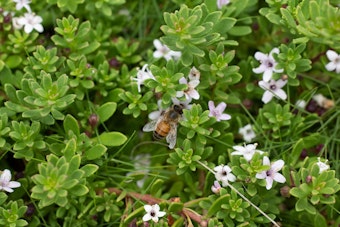
9. Myoporum
- Uses: Myoporum parvifolium is a mesic groundcover that can be grown in sun or shade and makes a great lawn alternative
- Growth Habit: This evergreen perennial is relatively short-lived and quickly grows to 18 inches tall by 8-15 feet in diameter.
- Color: Boasts a brief carpet of cream-white flwoers in April and bright green leaves
- Fruit: Produces very small purple berries
- Soil: Requires well-drained soil
- Light: Grows best in partial to full sun
- Water: Offers some drought tolerance once established, but grows best with infrequent, regular waterings
- Pruning: Head back to limit spread. May require partial or complete removal after 5-10 years if it acquires layers of undercanopy woody stems.
- Hardiness: 23oF
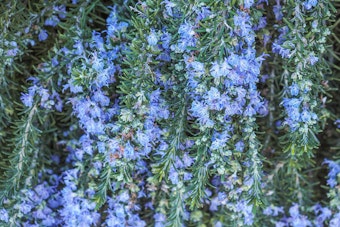
10. Trailing Rosemary
- Uses: Also known as Creeping Rosemary (Rosmarinus officinalis Prostratus Group) - this groundcover boasts fragrant foliage and colorful blooms, and can be enjoyed poolside. Useful for erosion control, and can be grown in containers or on retaining walls.
- Growth Habit: Trailing and moderately growing to 2 ft. tall and 4 ft. wide
- Color: Blue flowers bloom in spring and winter atop dark green, fragrant evergreen foliage
- Soil: Requires well-drained soil
- Light: Prefers full sun
- Water: Once established, requires deep infrequent watering; additional watering may be required in summer if soil has high clay content
- Pruning: Prune from underneath by removing deadwood. Will not recover if overpruned.
- Hardiness: 15°F
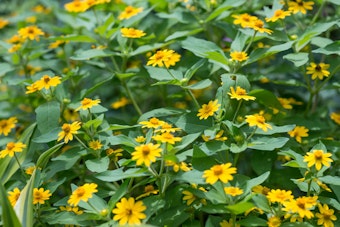
11. Yellow Dots
- Uses: Also known as Creeping Daisy and formerly as Wedelia trilobata (Sphagneticola trilobata) Yellow Dots is a mesic groundcover that's great for desert areas! It can also be used for living roofs and walls, and in container gardening.
- Growth Habit: This herbaceous perennial vine is prostrate and spreading, and moderately vigorous to 30 ft.
- Color: Boasts yellow flowers throughout the warm season, with green to dark green leaves
- Fruit: Fruits are achenes, tuberculate and rare in landscapes
- Soil: Prefers sandy, well-drained soils.
- Light: Can grow in shade to full sun
- Water: Prefers regular watering
- Pruning: Can be pruned to control spread; cut back hard to reduce clumping
- Hardiness: Very frost and freeze sensitive; will grow back in spring following winter damage
Speak with one of our Trusted Garden Advisors to learn more about which groundcover would grow best in your desert garden landscape!

